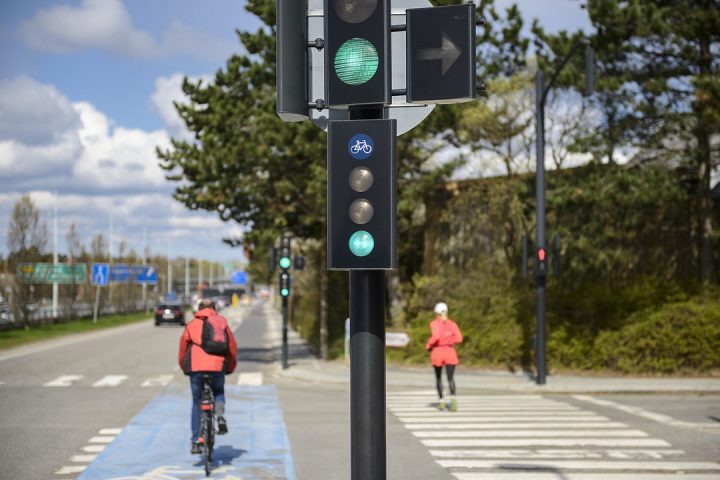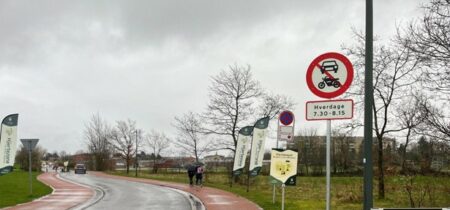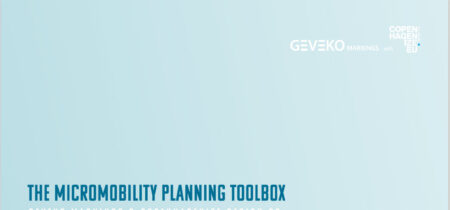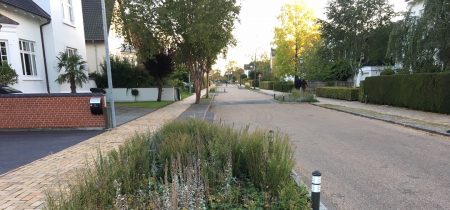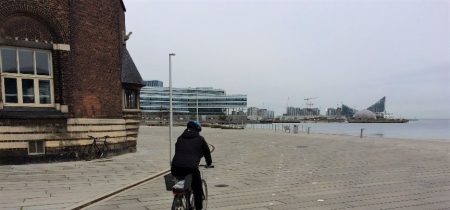Signal controlled intersections – safe cycling solutions
Signal controlled intersections are extremely important for cyclist safety and accessibility. Signal control doesn’t control everything, so road user behaviour should be reinforced by the correct detail solution, which depends on traffic flows and available space at the intersection.
By Troels Andersen, Odense municipality
Signal controlled intersections are often based on estimates of improved traffic flows, traffic safety and security. By separating cross traffic streams by time intervals, the likelihood of cross collisions (i.e. accidents) is reduced. On the other hand signal systems concentrate conflicts between turning traffic and traffic going straight ahead within a time interval, an issue which is normally not resolved by signal control, unless the signal system is conflict free. Crossing against the light may result in serious accidents.
The typical personal injury accidents involving cyclists at signal controlled intersections are accidents with right or left turning motor vehicles, and cross collisions where the cyclist crosses on red. Signal control yields a significant safety benefit outside intersections, which in urban areas is 1.5 times greater than the benefit in the intersection itself.
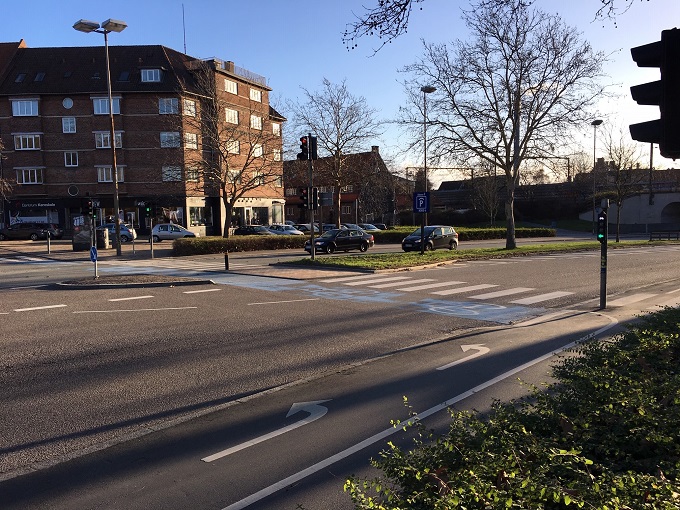
- Blue cycle crossing at a signal controlled intersection where there is a heavy flow of oncoming left turning vehicles. Photo Troels Andersen
Cyclist visibility depends on the intersection’s geometrical and visual size. Parked cars and stopping buses near the intersection can reduce cyclist visibility. So decide whether they should be removed up to the intersection.
Right turn/left turn arrows for cars
At intersections without a separate cyclist phase cyclists follow the car phase. Arrow signals apply to road users driving in the direction of the arrow. However, cyclists may not use drivers’ left turn arrow since according to the Road Traffic Act they must turn left in two phases: first proceed to the opposite side of the intersection, and then make the left turn when this can be done without inconveniencing other traffic, regardless of whether the light is red or green. However, the latter rule is not generally known, and so space is needed for cyclists waiting at the corner.

- The Danish left turn rule is that cyclists first need to cycle to the opposite corner where they don’t necessarily have to wait for the green light to cross. Nevertheless it’s a good idea.
Cyclist signal phases
At intersections where cycle tracks or cycle lanes are continued to the stop line, a separate signal phase for cyclists can be established. Thus cyclists have their own signal phase either wholly or partially. At intersections with separate cyclist phases cyclists must always follow the signal.
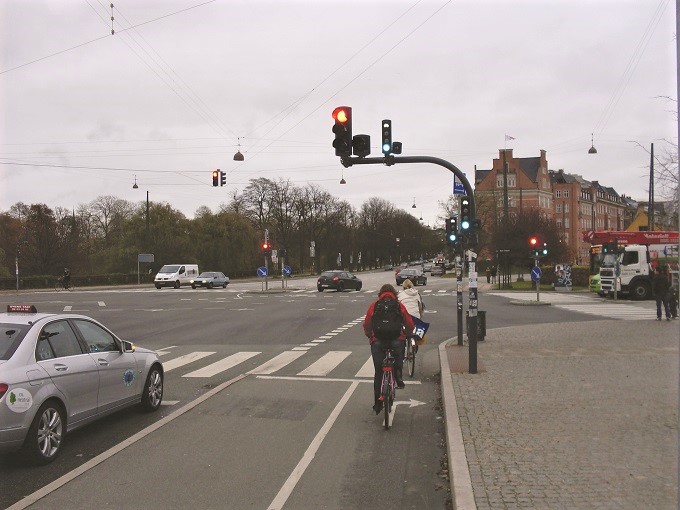
- Pre-green for cyclists can reduce the number of accidents at the start of the green phase. Photo Troels Andersen
Cyclist phases can be used to give cyclists pre-green, i.e. cyclists get the green signal a few seconds before cars. This gives cyclists who have stopped for the red light a head start on cars, and cyclists become more visible. The aim is to reduce the number of conflicts between cars and cyclists.
In addition, cyclist phases can be used to reduce cyclist green time so turning motor traffic can flow more easily. This increases cyclist waiting times, however, and does little to encourage the cyclist’s desire to cycle.
At intersections with two or more turning lanes entering the intersection, the turning lanes should have a separate phase since it can be hard to see the cyclists. The duration of the green phase for cyclists going straight ahead or turning left will consequently be reduced.
Danish planners have started testing cyclist phases with a countdown function. The waiting time seems shorter, and a countdown signal may keep cyclists from crossing against the light, as it does for pedestrians. The challenge is that almost all controlled systems today are traffic actuated intersections without set circuits for green and red phases. Visual display of remaining time is being tested on the Cycle superhighway Allerød route, i.e. expressing remaining time in visual bars rather than number of seconds.
Detecting cyclists in traffic actuated systems
In traffic actuated systems, traffic from the different directions control the duration of the green phase. Coils are installed in the road to report motor traffic to the signal. Bicycles can be detected via coils, radar, video, or manually by pressing a button. Sometimes cyclists and pedestrians are detected by the same button, elsewhere they each have their own stand.
The optimal system for cyclists is both a coil in the road and a separate manual cyclist button placed on a low stand at the stop line. When a cyclist is detected, the message received signal lights up. If unexpectedly the light isn’t activated the cyclist can activate the signal by pressing the button.
When coils are installed in the cycle track/cycle lane at a certain distance before as well as at the stop line, cyclists can be detected in time for the signal to change from red to green or to prolong the green phase so cyclists don’t need to stop.
At certain intersections left turning cyclists can only be detected by placing coils in front of the stop line. To prevent crossing cyclists from activating the signal unnecessarily, the coil should be under pressure for at least two seconds before it activates. The location of the coil can be shown with thermoplastic to make it clear to cyclists. This encourages more cyclists to place themselves correctly on the coils.
The advantage of using coils to detect cyclists is that waiting times are reduced and the cyclist doesn’t have to press a button. The disadvantage of manual detection is that not all cyclists are aware of the button, and may become impatient and cross on red. The disadvantage of automatic cyclist detection is that cyclists can only be detected if they stop within a certain area. This area should consequently be clearly marked if no self-explaining solution can be found.
Work is being done on new types of detection where an app on the cyclist’s smartphone activates the signal at a distance from the intersection. When the message is received the phone vibrates and lights up. This is an advantage in all the traffic light intersections which don’t have cyclist coils at an appropriate distance from the intersection.
Cycle track/cycle lane up to the intersection
At signal controlled intersections where cycling speeds are not particularly high, it’s basically a good idea to continue the cycling solution up to the stop line, and mark a cycle crossing through the intersection. If fast cycling makes this undesirable (for example, a down- hill incline), and if there are no turning lanes for motor traffic, a cycle track up to the intersection is safer than a shortened cycle track. Set-back stop lines and blue cycle crossings can provide additional safety. Cycle tracks up to the stop line have the advantage that they satisfy cyclist demand for their own area and make them feel more secure.
At intersections where there are many right turning lorries, cycle tracks up to the intersections should only be used sparingly since lorry drivers have trouble seeing cyclists on the right side of the lorry. Part of the safety issue can be resolved by setting the stop line for motor traffic 5 meters behind the pedestrian crossing and establishing a cycle crossing through the intersection.
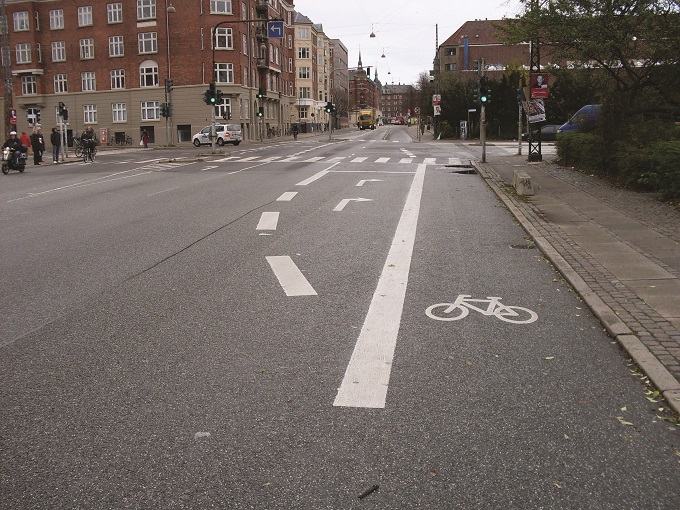
- Set-back stop lines don’t significantly reduce intersection capacity. Photo: Troels Andersen
When a cycle lane leads up to the intersection, squeezing between bicycles and cars can be prevented by separating the cycle lane from the traffic lane with a profiled stripe. Profiling sharpens drivers’ concentration.
In order to create more space for a right- turn lane and a better interaction between right turning cars and cyclists going straight ahead, a wide cycle track/lane can be continued as a narrower cycle lane on the last 20-60 m up to the stop line. This can reduce the number of cycling accidents with right turning cars, but where bicycle traffic is dense it may also reduce capacity unless it’s combined with a cycle box in front of the right turn lane.
Shortened cycle tracks/lanes
At signal controlled intersections with fast cycling speeds, for example when the cycle track has a steep downhill incline, it’s important to shorten the cycle track/lane for safety reasons. Cyclists and drivers on the same level are physically closer to each other, and are both responsible for conflicts if the cycle track is shortened by 20-30 m minimum before the intersection. (The length depends on the number of right turning vehicles. Furthermore, a long combination vehicle is 25 m long). To ensure that cars as well as cyclists have enough space the width of the right- turn lane should be 4 m or more. This is also an appropriate solution where there are many mopeds. If the only way to make space for a right- turn lane for cars is to shorten the cycle track/lane, then it’s probably best from a safety point of view to shorten the cycle track rather than not have a right turn lane at all.
At intersections with shortened cycle tracks there should be no entrances or exits on the shortened stretch before the intersection. Shortened cycle track/lanes should not be applied at intersections where there are many children, since it’s an insecure solution, and children cycle slowly. Insecure solutions may mean that fewer cyclists feel like cycling on the stretch.
Set-back stop lines
It is recommended at all signal controlled intersections to set back stop lines for cars in all traffic lanes 5 m behind the pedestrian crossing or the cyclist stop line. Set-back stop lines increase pedestrian and cyclist visibility during signal changes and enable light road users to enter the intersection earlier, preventing a number of conflicts. An accident study showed a 35% reduction in the number of accidents between right turning cars and cyclists going straight ahead, and a 50% reduction in the number of injured cyclists in this type of accident.
When it’s a question of fatalities where a bicycle/moped is hit by a right turning opposite party, the opposite party in 90% of cases is a lorry. Set- back stop lines increase cyclist visibility for lorry drivers. A recent study of set- back stop lines shows there is no drop in the number of situation 312 accidents (right turn in front of other vehicle) after establishment of set-back stop lines. When there are one or two traffic lanes the set-back stop line has a positive effect on the number of accidents.

- Many cyclists experience a cycle lane between motor vehicles’ right turn and straight ahead lanes as insecure. Photo Troels Andersen
Cycle lane between motor vehicles’ right turn and straight ahead lanes
At large signal controlled intersections a cycle lane between the right turn and straight ahead lane may be established. The idea is to replace the conflict between right turning cars and cyclists going straight ahead with a less dangerous situation where they weave before the intersection. At the same time, cyclists going straight ahead are more visible to oncoming, left turning drivers. The measure can be combined with a cycle crossing within the intersection area.
An accident study of this measure has not been able to document a safety effect. The solution is experienced as insecure by many cyclists, especially children and the elderly.
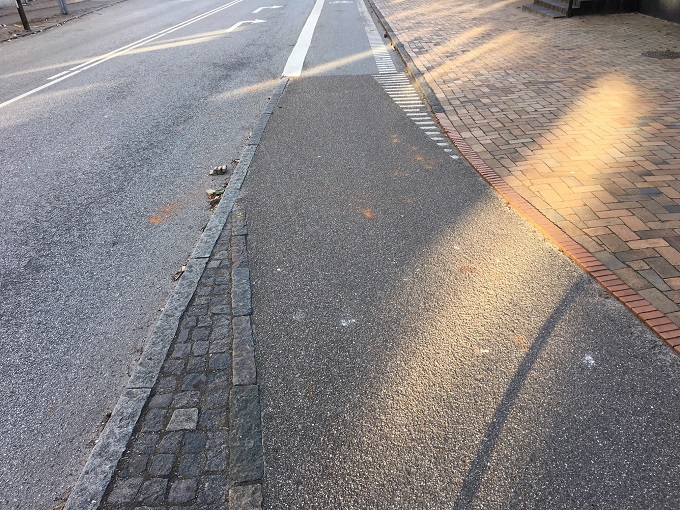
- Shortened cycle track continued as a narrow cycle lane. Photo: Troels Andersen
Mixed traffic
On approaches to signal controlled intersections with mixed traffic, short, narrow 1.5 m wide cycle lanes may be installed on the final 20-50 m before the intersection. Cyclists have their own dedicated area up to the intersection, and security and accessibility are consequently improved. It is unclear whether this is better than nothing from a safety point of view. The solution makes it possible to mark a cycle crossing through the intersection. However, cycle crossings may be marked even if there are no cycling facilities directly before the intersection.
Cycle crossings through intersections
When it seems likely that attention needs to be drawn to the potential conflict between cyclists going straight ahead and turning drivers, a marked cycle crossing can be established. In addition to drawing attention to the conflict area, the cycle crossing visually separates cyclists going straight ahead from drivers, and cyclists feel more secure.
In Denmark four types of cycle crossing are used, one of which is blue, while the others consist of white dotted 0.3 m wide edge lines. Cycle crossings always have bicycle symbols.
An accident study of cycle crossings at signal controlled intersections shows that marked cycle crossings result in a 36% drop in the number of cycling accidents and 57% in the number of seriously injured cyclists. In addition, the study showed that when cycle crossings were installed at major intersections, the primary reduction occurred in the number of left turning cars and cyclists going straight ahead. Drivers seem to shift part of their attention from pedestrians to cyclists, since the number of pedestrian accidents increased during the same period.
Another study shows that one blue cycle crossing per controlled intersection gives a safety benefit, but two blue crossings should only be installed as an exception in controlled T- intersections. Three and four blue cycling crossings increase the number of accidents. Blue lanes should be placed where accidents occur between cars and cyclists.
Channeling cyclists at intersections
At intersections with a large share of cyclists, it’s a good idea to channel the cyclists in a separate right turn lane and a straight ahead lane. The advantage of channeling is that the cyclists position themselves in the most effective way to enter the intersection. The cycle lane should be wide enough that two cyclists can stop next to each other, i.e. at least 1.85 m wide. Without channeling there is the risk that cyclists will cycle on the pavement or stop in front of the stop line, in the pedestrian crossing, or in front of cars. On the other hand a right turn lane for cyclists shouldn’t be installed where there are relatively few cyclists.
At intersections with mandatory right turn or separate right turn phases, cyclists should always be channeled. In practice there may be space issues with waiting cyclists even though the queue is not too long for the last cyclist to make it over the during the first green phase. When there are many right turning cyclists a traffic island between right turning cyclists and cyclists going straight ahead may be a good idea, and perhaps cyclists on the right don’t need to be controlled by a signal phase, but by a right of way slip shunt.
At both controlled and right of way T- intersections a left turn lane on the cycle track rather than the side road is always a good idea.
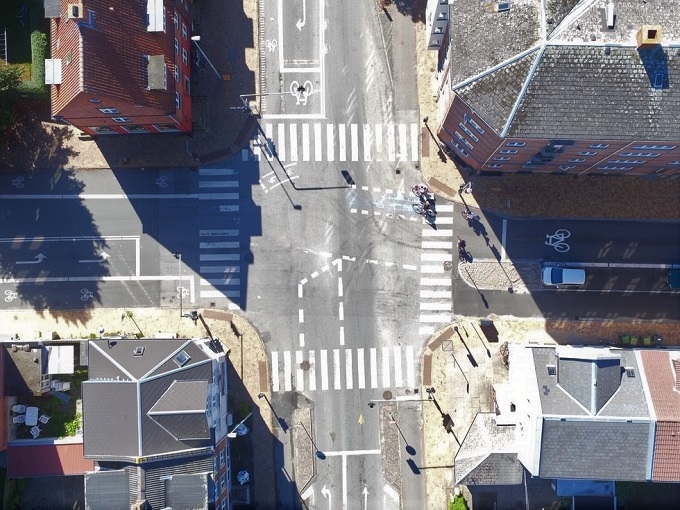
- Here are several excellent cycling solutions. Top: a cycle pocket, Right: a bicycle street, Bottom left: set-back stop lines, Left: marked left- turn coil for cyclists. Photo: Odense municipality
Sources
Lahrmann, Harry og Leleur, Steen (1994): Vejtrafik – Trafikteknik & Trafikplanlægning, Polyteknisk Forlag.
Søren Underlien Jensen, Trafitec (2009): Safety Effects of Intersection Signalization: a Before-After Study
Søren Underlien Jensen, Trafitec (2006): Effekten af cykelstier og cykelbaner.
Behrensdorff, Inge og Hansen, Lars Klit (1994): Sidespejle på lastbiler – brug og effekt af nærzone og vidvinkelspejle, Rådet for Trafiksikkerhedsforskning.
Herrstedt, Lene; Nielsen, Michael Aakjer; Ágústsson, Lárus; Krogsgaard, Karen Marie Lei; Jørgensen,
Else og Jørgensen, N.O. (1994): Cyklisters sikkerhed i byer, Rapport 10, Vejdirektoratet.
Jensen, Søren Underlien og Nielsen, Michael Aakjer (1996): Cykelfelter – Sikkerhedsmæssig effekt i signalregulerede kryds, Rapport 51, Vejdirektoratet.
Trafitec (2006): Effekter af overkørsler og blå cykelfelter.
Trafitec (2009): Cykellommer – Spørgeundersøgelse om tryghed, tilfredshed, mv.
Sikkerhedseffekter af tilbagetrukne stopstreger, Trafitec, 2012


